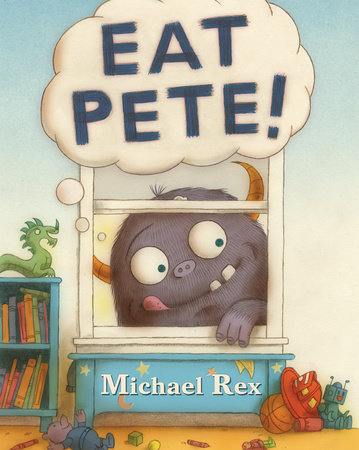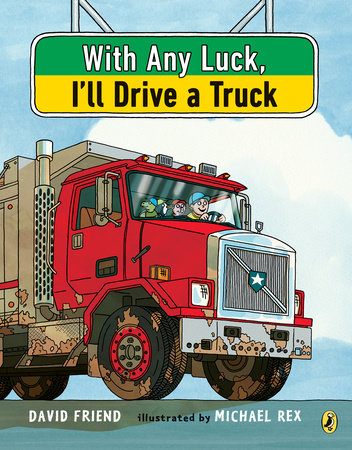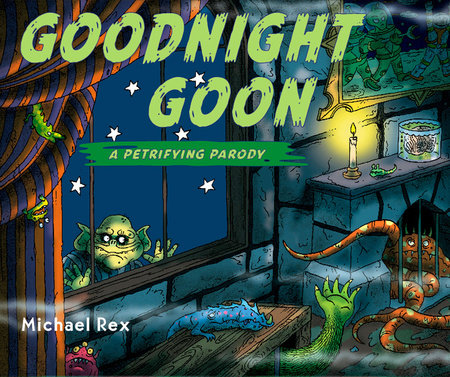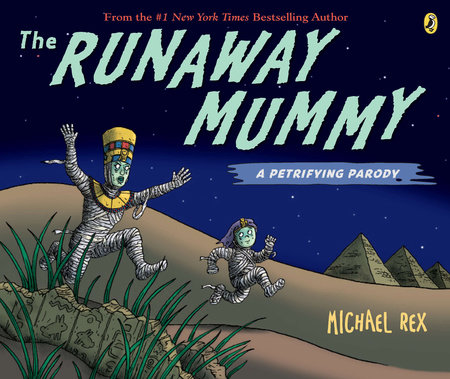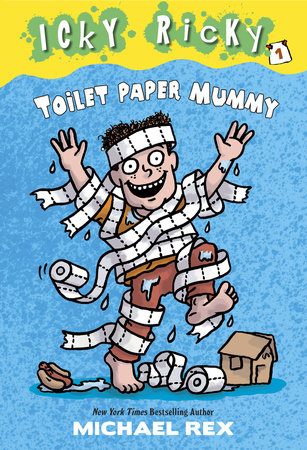Meet the Illustrator: Michael Rex
by the Brightly Editors
In this installment of Meet the Illustrator, we chat with Michael Rex, creator of the new picture book Eat Pete and illustrator of With Any Luck, I’ll Drive a Truck, a picture book written by David Friend that features a little boy with a huge imagination. At its core, With Any Luck, I’ll Drive a Truck is a counting book; readers count the passing years of a vehicle-filled adventure as the boy operates a big crane on a building site, uses his fireman’s truck to save a cat stuck in a tree, and works a combine on a farm. But there’s a sly humor to Michael Rex’s illustrations, and the book’s sweet surprise ending will make you want to flip back to the beginning to read it again.
What first made you excited about art?
I don’t remember a time when I wasn’t drawing and making things. It always felt very natural and “right.” School never really clicked for me, and I wasn’t an athlete. So the arts were the only place I felt capable on any level. My parents were very supportive and never discouraged me from following that path, which is a good thing because I can’t even count the times that educators told me I was wasting my time with art — that I should spend my time on something “more productive.”
I drew a lot as a kid. I made animated films, I wrote goofy stories — all that good stuff that gets a kid to end up in a profession like children’s book writing and illustrating. One of the most important elements of my parents’ support was that my mom always cut out articles from magazines and newspapers about anyone who made their living drawing comics or illustrating. She knew that it was a “real job” and made sure that I knew it too. It was never looked at a hobby or a diversion. The idea that I could do what I loved to do as a career when I grew up excited me.
Also, maybe even more importantly, I like the idea of creating something, either a drawing or a story, that was not there at the start of the day.
What illustrated book from childhood has stayed with you over the years?
I was a big Richard Scarry fan when I was a child. Those were the books that I remember spending time with. Searching through the details, reading all of the labels, and looking for Lowly Worm was great fun. I also vividly remember the Curious George books.
There’s another book that I loved, that I do not own and have not been able to find the name of. It was about a few boys who sleep outside one night, and believe they see a monster, but when the sun comes up, they find out that it’s only some cornstalks that have become tangled together. The really cool thing about this book was that at the end of it, it had directions for making a shield and mask — and maybe a spear or something. The illustrations were two-color (black and blue) and I really loved the world presented in that book. In a way, sometimes my memory of a book is more powerful than the book itself.
Oh! And Syd Hoff. I loved Syd Hoff’s books.
Where do you find inspiration for your drawings?
Inspiration is a tough thing to nail down. Throughout my life, so many things have inspired me that it really is almost impossible to begin writing about them. However, one thing that has been on my mind lately is that often the things that really, truly, and deeply inspire me are insanely different from what I actually do. While I am certainly excited by all sorts of illustration — from daily comics, to ’50s sci-fi book covers, to vintage picture books, to animated film design — some of my most profound inspirations aren’t images at all.
For instance, music is really important to me. David Bowie inspires me to try to do something different every few years. The Kinks inspire me to make sure that there’s always a story in each drawing. The Jam inspires me to keep things simple. The Talking Heads inspire me to add detail and layers.
I could go on and on, but I do want to add one thing about inspiration: I think it’s important to draw from as many different places as possible. So if you’re aspiring to be a picture book artist, looking at picture books is great. But pull something in from outside of that field. Look at fine art, look at logos, look at graffiti, watch films, read nonfiction, absorb the real world around you. Nothing’s duller than looking at a drawing that looks like it was made by someone who knows nothing but drawing.
What does your workspace look like?
I work in the attic of my house; it’s very long and the roof is slanted on either side. It’s a little like being in a submarine. It’s usually pretty cluttered with books, art supplies, more books, and some of my toy collection. I have one big drawing table, and another table with my computer. Recently, I added a Wacom Cintiq, which allows me to create digital illustrations by drawing directly onto the screen. It’s like a very high-end, heavy-duty iPad. While my studio isn’t as bright as I’d like, one of my favorite things about it is that there is a set of “Amityville Horror” windows on one end.


What materials do you most like to use?
As far as materials go, all of my illustrations start with traditional media. I use pencils, paper, markers, vellum for tracing, and Bristol board on occasion. When I started in 1995 my finals were drawn with a black colored pencil, but I used a quill and ink for Goodnight Goon and my other parody books. I also use Q-tips (clean ones!) to smudge pencil and create values. I’ve used paper blenders, but found the small cotton swabs to be very useful. For my Fangbone! graphic novels, I wanted a quick, loose line so I ended up using thin Sharpie. Drawing with a Sharpie can be like drawing with a fire hose, but it made me work fast and stay away from adding too much detail.
For With Any Luck, I’ll Drive a Truck, I wanted the lines to be very uniform so I used a thin black Copic marker.

Once all of the drawing is done, I add all of my color and textures digitally using Photoshop. I also use it for correcting drawings, adjusting compositions, and adding details I may have missed. The trucks in this book were as accurate as possible, and I would sometimes miss a detail and put it in weeks after I thought I was done. The problem with doing too much digital work, however, is that when I start to draw with pen and paper, I often want to reach for the “Undo” button.
What design resources would you recommend to young artists?
For young artists, I always stress that the most important thing that they can do is to look at the world around them. It is a literally endless stream of information offering unlimited design possibilities. Years ago, I was doing a week-long school visit — a sort of short-term residency — and I was set up in the art room. The room looked out over a playground, and then to a street of suburban houses. When the students came in, I asked them each to draw a house. Naturally, most drew a square with a triangle on top. Some ambitious students added a chimney.
I then brought the class over to the windows and we looked at all the real houses. For ten minutes, we talked about shapes, details, textures, and anything else they could point out. I then had them go back to their tables and we started over. I asked them all to draw another house. The difference between the first drawings and the second drawings was striking. The kids felt so proud because these houses looked like “real” houses.
How do you get kids excited by art?
To me, I find it very exciting to see exactly how something is done, so when I do school visits I make sure to do a step-by-step, live drawing demo for the students. I make sure that they see that illustration is a process that can be learned and not some sort of “talent.” I always say that talent is the ability to stick with something and be able to do it over and over until it’s right.
I have, in the past, seen illustrators do things that seemed more like parlor tricks. Saying to the kids, “Look how fast I can draw my cartoon characters!” is fun, but offers no educational value at all.
What have your kids taught you about books and reading?
I’m glad this question came up. One of the most important things that I’ve learned from my kids, and children I meet at school visits, is that they don’t care if you had a starred review in Kirkus. It doesn’t matter to them if you were written up in the New York Times, they don’t ask how many friends you have on Facebook, and they don’t follow Twitter. They see the book for what it is, and not all the nonsense that can surround it. Spending time with children who are reading my books forces me to think about the work, (the writing, the drawing, the pacing, the layout) and to forget all of the superfluous baloney that can weigh a creator down.
What’s the best color name you’ve ever heard of?
Hmmm, I work digitally, so that’s a tough one. However, when I do my sketches I use a Prismacolor pencil called “Non-Photo Blue.”

It’s a holdover from when artwork was photographed to be reprinted. Cameras only picked up black or white, so this special blue wouldn’t be seen.
-
Books by the Author:
-
With Any Luck, I’ll Drive a Truck
Also available from:Goodnight Goon
Also available from:Runaway Mummy
Also available from: -
Icky Ricky Series
Also available from:FangBone: Third-Grade Barbarian Series
Also available from:
Michael Rex is the creator of over thirty books for children, including the number one bestseller Goodnight Goon and the Fangbone! series. He was inspired to create Icky Ricky by his two boys, Declan and Gavin, who are fine young citizens, but very disgusting. Gavin eats ketchup on cake, and Declan uses a marker to color his belly button. Along with the boys, Mr. Rex lives with his wife and their dog, Roxy, in Leonia, New Jersey. Both his wife and the dog are not disgusting at all. Visit him at mikerexbooks.blogspot.com. You won’t get dirty.

